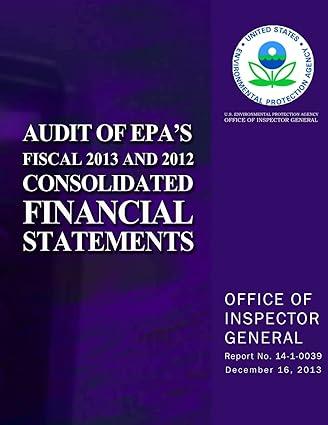Question
RI7-2 (Inventory turnover and valuation) Brick Brewing Co. Limited is a Canadian-owned brewery with its head office in Kitchener, Ontario. The company brews, sells, and
RI7-2
(Inventory turnover and valuation)
Brick Brewing Co. Limited is a Canadian-owned brewery with its head office in Kitchener, Ontario. The company brews, sells, and markets its products under the Waterloo, Laker, Red Baron, Red Cap, and Formosa brand names. The company also produces, sells, markets, and distributes Seagram's Coolers across Canada. The information in Exhibits 7.24A to 7.24C was taken from the company's 2017 annual financial statements.
EXHIBIT 7.24ABrick Brewing Co. Limited's Statements of Financial Position
BRICK BREWING CO. LIMITED
Statements of Financial Position
(As at January 31, 2017 and January 31, 2016)
|
| Notes | January 31, 2017 | January 31, 2016 |
| ASSETS |
|
|
|
| Non-current assets |
|
|
|
| Property, plant and equipment | 12 | $21,709,425 | $21,986,070 |
| Intangible assets | 13 | 15,499,186 | 15,375,392 |
| Construction deposits |
| 2,462,328 | - |
| Deferred income tax assets | 11 | - | 1,262,769 |
|
|
| 39,670,939 | 38,624,231 |
| Current assets |
|
|
|
| Cash |
| 2,831,959 | 393,645 |
| Accounts receivable | 14 | 7,035,714 | 6,176,421 |
| Inventories | 15 | 5,619,329 | 3,291,529 |
| Prepaid expenses |
| 593,180 | 354,650 |
|
|
| 16,080,182 | 10,216,245 |
| TOTAL ASSETS |
| $55,751,121 | $48,840,476 |
| LIABILITIES AND EQUITY |
|
|
|
| Equity |
|
|
|
| Share capital | 16 | $39,651,096 | $39,526,573 |
| Share-based payments reserves | 17 | 943,565 | 932,201 |
| Deficit |
| (2,758,560) | (4,933,195) |
| TOTAL EQUITY |
| 37,836,101 | 35,525,579 |
| Non-current liabilities |
|
|
|
| Provisions | 19 | 411,599 | 388,548 |
| Obligation under finance lease | 20 | 3,781,855 | 4,523,152 |
| Long-term debt | 21 | 2,498,580 | 1,548,584 |
| Deferred income tax liabilities | 11 | 82,389 | - |
|
|
| 6,774,423 | 6,460,284 |
| Current liabilities |
|
|
|
| Accounts payable and accrued liabilities | 23 | 9,655,405 | 4,908,722 |
| Current portion of obligation under finance lease | 20 | 741,297 | 713,699 |
| Current portion of long-term debt | 21 | 743,895 | 1,232,192 |
|
|
| 11,140,597 | 6,854,613 |
| TOTAL LIABILITIES |
| 17,915,020 | 13,314,897 |
| COMMITMENTS | 25,26 |
|
|
| TOTAL LIABILITIES AND EQUITY |
| $55,751,121 | $48,840,476 |
EXHIBIT 7.24BExcerpt from Notes to Brick Brewing Co. Limited's 2017 Financial Statements
BRICK BREWING CO. LIMITED
Excerpt from Notes to Financial Statements
5.10. Inventories
Inventories are recorded at the lower of cost and net realizable value. Cost includes expenditures incurred in acquiring the inventories and bringing them to their existing location and condition. Net realizable value is the estimated selling price in the ordinary course of business, less the estimated costs to complete and sell the product.
The cost of raw materials and supplies are determined on a first-in, first-out basis. The cost of finished goods and work-in-process are determined on an average cost basis and include raw materials, direct labour, and an allocation of fixed and variable overhead based on normal capacity.
Inventories are written down to net realizable value if that net realizable value is less than the carrying amount of the inventory item at the reporting date. If the net realizable value subsequently increases, a reversal of the loss initially recognized is applied to cost of sales.
EXHIBIT 7.24CExcerpt from Notes to Brick Brewing Co. Limited's 2017 Financial Statements
BRICK BREWING CO. LIMITED
Excerpt from Notes to Financial Statements
15. Inventories
The inventories balance consists of the following:
|
| January 31, 2017 | January 31, 2016 |
| Raw materials, supplies and other | $1,991,068 | $1,568,442 |
| Work in progress and finished goods | 3,628,261 | 1,723,087 |
|
| $5,619,329 | $3,291,529 |
As at January 31, 2017, a provision of $121,170 (January 31, 2016 $56,670) has been netted against inventory to account for obsolete materials.
The cost of inventories recognized as cost of sales during the year ended January 31, 2017 are $25,126,291 (January 31, 2016 $22,766,711). Included in this amount are charges related to impairment caused by obsolescence. During the year ended January 31, 2017, these charges amounted to $97,780 (January 31, 2016 $22,446).
Required
a.
Note 15, shown in Exhibit 7.24C, breaks down Brick's inventory into two classifications. Which classifications of inventory do you believe should be used in determining the inventory turnover ratio? Why?
b.
Describe Brick Brewing's inventory valuation policies in your own words. Specifically, explain what Brick Brewing includes in inventory cost, what cost formula(s) the company uses, and how it values its inventory on the statement of financial position.
c.
Calculate the inventory turnover ratio and days to sell inventory ratio for 2017 and 2016. Use the inventory values in 2017 and 2016 rather than the average inventory to calculate the ratios. Explain the amounts you selected from the financial statements to use in your calculation.
Step by Step Solution
There are 3 Steps involved in it
Step: 1

Get Instant Access to Expert-Tailored Solutions
See step-by-step solutions with expert insights and AI powered tools for academic success
Step: 2

Step: 3

Ace Your Homework with AI
Get the answers you need in no time with our AI-driven, step-by-step assistance
Get Started


